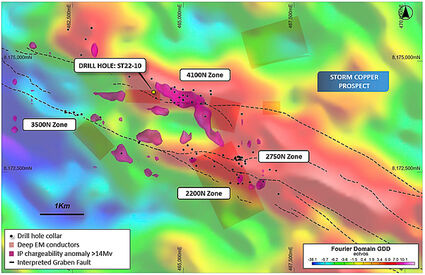Deep drill discovery at Storm Copper
Drills tap sediment-hosted copper under surface high-grade North of 60 Mining News – September 30, 2022
Last updated 9/29/2022 at 2:32pm

American West Metals Ltd.
Copper sulfide mineral chalcopyrite within core from a one-meter intercept averaging 0.41% copper encountered at a depth of 313 meters in hole ST22-10 drilled at Storm.
American West Metals Ltd. Sept. 28 reported that assays confirm that its deep discovery drilling at Storm has encountered a new style of sediment-hosted copper-zinc mineralization below the high-grade copper at this northern Nunavut project.
In August, the Australia-based exploration company reported that hole ST22-10 cut 68.8 meters of mineralization from a depth of 277 meters. This hole was drilled to test a deep electromagnetic geophysical anomaly below the high-grade copper mineralization found at surface in the 4100N zone at Storm.
Assay results show that this hole cut five layers of low-grade zinc from depths of 29 to 150 meters, three layers of low-grade copper from 313 to 325 meters, followed by another layer of low-grade zinc starting at 358 meters.
While ST22-10 did not encounter high-grade copper similar to what is being drilled near the surface at Storm this year, American West says the mineralization in this hole appears to be at the edge of a much larger sediment-hosted copper-zinc deposit at Storm.
"I am very pleased to be able to report that initial assays from drill hole ST22-10 confirm the presence of sediment hosted type copper and zinc sulphide mineralisation, with huge implications for the potential metal endowment of the project," said American West Metals Managing Director Dave O'Neill.
The company says a compilation of historical induced polarization, gravity, and electromagnetic data reveals a series of large anomalies that sit under and adjacent to the known high-grade copper mineralization found at surface.
The metal associations, zonation, and geophysics suggest that hole ST22-10 is potentially on the edge of a stronger mineral system.
"These features occur across a zone more than 5,000 meters long, supporting the potential for a very large sedimentary copper system," said O'Neill. "This is a tremendous exploration opportunity, and we are already planning follow-up exploration and drilling."
2750N and looking ahead
While hole ST22-10 tested the deeper and potentially larger copper potential at Storm, the main thrust of American West's 2022 drill program was to build a near-surface, high-grade copper resource that can be upgraded to direct shipping ore with simple and low-cost ore sorting technology.
This includes eight holes drilled at the 2750N zone. Highlights from the three holes drilled there so far include:
• Six meters averaging 2.3% copper from a depth of 65 meters in hole ST22-01.
• 57 meters averaging 2.5% copper from a depth of eight meters in hole ST22-02
• 41 meters averaging 4.18% from a depth of 83 meters in hole ST22-05.
Assays are pending for five additional holes drilled at the 2750N zone.
"Further assays from the Storm drill program are due soon and we look forward to reporting on these as they come in," said O'Neill.

American West Metals Ltd.
Hole ST22-10 was drilled toward the northwest end of a strong induced polarization and the northeast corner of a deep electromagnetic geophysical anomaly at Storm Copper.
Beneficiation testing focused on further optimizing a process to produce a direct shipping product using ore sorting is expected to begin soon. The remaining half core from drill hole ST22-02 will be used for this testing.
The company is already looking ahead to its 2023 field program, which is expected to include additional drilling of the near-surface high-grade copper mineralization at 2750N; drilling to define initial resources at 4100N and 2200N, where historical drilling cut thick, near-surface zones of high-grade copper mineralization; and an electromagnetic geophysical survey and further drilling to follow-up on the discovery of deeper sediment-hosted copper mineralization at Storm.







Reader Comments(0)